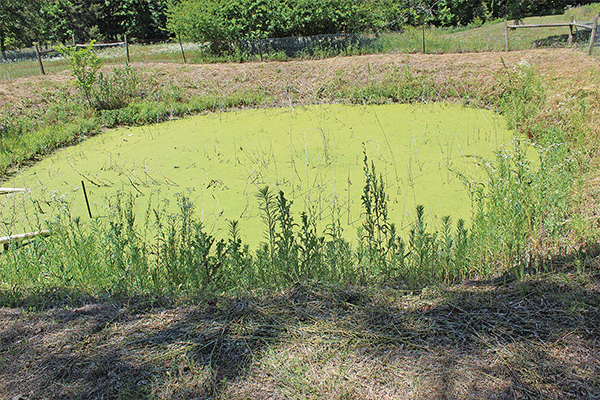MEDICINE PARK – Various improvements to the municipal sanitary sewer system, including some needed for quite awhile, have been undertaken in recent weeks.
One project “we have been working on for years” is a sewer line rehabilitation project and plans for construction of a third cell at the sewage treatment lagoon, Town Trustee Dale Nomura said.
Medicine Park officials have been in discussions with the state Department of Environmental Quality (DEQ) and with the U.S. Department of Agriculture’s Rural Development division for eventual construction of an additional sewage lagoon cell.
“In order to do this, we first had to decrease the inflow and infiltration (“I&I”) before DEQ would even consider a new lagoon,” Nomura said.
Infiltration and inflow are excess water that flows into sewer pipes from stormwater and subterranean groundwater. “Infiltration” is groundwater that seeps into sewer pipes through holes, cracks, joint failures and faulty connections. “Inflow” refers to water discharged into a sewer system from such sources as yard and area drains, foundation drains, manhole covers and surface runoff.
In Medicine Park, excess water enters the sanitary sewer system after a rainstorm, overwhelming the sewage treatment lagoon.
Consequently, the DEQ instituted an enforcement action against the town. Town officials were ordered to seal any leaking manholes and sewage collection lines and prevent sewage bypasses from the treatment lagoon, said Erin Hatfield, the state agency’s communications director.
“We smoke-tested” the sewer lines “and had municipal sewer lines and private lines alike repaired,” Nomura said.
In addition, the Public Works Authority (PWA) team “worked very hard to come up with a solution for the manholes where a lot of I&I was occurring,” she said. The tops of the manholes were sealed to prevent infiltration from above, and a particular type of concrete is being applied around each manhole to prevent groundwater from entering the system.
“We have finished 75% of the manhole project and reduced our I&I significantly,” Nomura said.
Town officials are thinking about buying and installing a flow meter for the sewage collection/treatment system. “This would help greatly by providing accurate reading of what is actually coming into our sewer system,” Nomura pointed out.
Another project was repair of the “auto bridge” sewage lift station, which had been on the town’s capital improvements program “for a number of years,” Nomura said. “The pumps were old; one was not working at all and the other had been failing occasionally.”
No vendor was willing to enter the lift station manhole to replace the pumps without shutting down the system, she said.
“We worked with an engineering firm and they presented us with different options for fixing those pumps,” Nomura recalled, “but the engineering options ranged from $150,000 to $250,000.”
Instead, Bill Chandler, the town’s Public Works Authority (PWA) supervisor, “went down into the lift station to obtain information about the pumps,” Nomura said. “We were then able to order them, and Bill and his team installed them for a cost under $18,000.” The lift station “is working well again,” Nomura said.
The “auto bridge” is the span between Riverside and Cobblestone Row and connects East Lake and West Lake.
A similar project was the repair of a smaller sewage lift station at Water Street. Two pumps in that facility malfunctioned recently.
The original pumps cost more than $17,000 apiece. “We reviewed bids on replacement of those units,” but PWA Clerk Anthony Fontaine “found other pumps that will do the job and cost a lot less,” Nomura said. The town trustees “approved our staff to again do the work, saving thousands of dollars.”
In a related matter, town leaders have been relying on porta-potties instead of the town’s public restrooms.
The public restrooms, next to the fire station on East Lake, repeatedly have been damaged. Vandals ripped sinks from the walls, tore down cubicle walls, and stole fixtures and paper products. In an attempt to prevent the vandalism, the restrooms were closed during festivals and the Medicine Park Economic Development Authority (MPEDA) brought in porta-potties.
After the coronavirus pandemic arrived in Oklahoma in mid-March, Medicine Park officials closed the restrooms indefinitely “because we cannot keep them clean in accordance with the standards required by the Centers for Disease Control and Prevention, while protecting our town employees from infection,” Nomura said.
The town trustees have partnered with MPEDA on several public health measures. Six porta-potties for general public use and two designed specifically for handicapped individuals, along with three hand-washing stations, are being rented at a combined cost of $845 per month, and an extra cleaning is being performed at a cost of $1,100 per month, Town Treasurer Yolonda Ramos said.
MPEDA is evaluating a plan to construct new restrooms in Bath Lake and Hitching Post Park, Nomura said. Additionally, the town’s Board of Trustees wants to place more hand-washing stations throughout town and is “going to see if the porta-potties can be cleaned more frequently on weekends, using federal CARES Act dollars,” she said. The portable restrooms and the extra cleaning cost $1,945 a month, which is “very expensive for us,” she noted.


